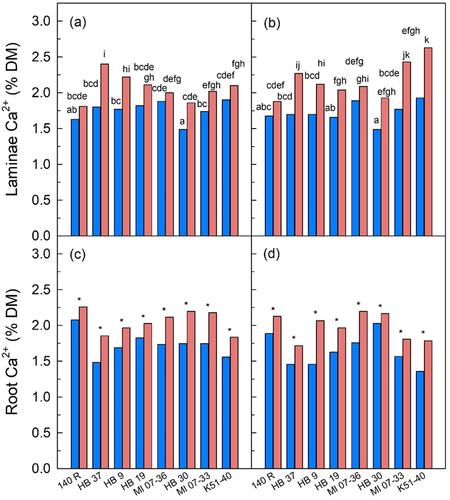Rootstock type influences salt exclusion response of grafted Shiraz under salt treatment at elevated root zone temperature
Abstract
Background and Aims
The temperature of the upper soil zone lags but strongly correlates with prevailing air temperature. The effect of root zone (RZ) temperature on shoot salt exclusion is poorly understood. The aim was to gain a better understanding of the effect of RZ temperature on the salt exclusion, growth and stomatal conductance of Shiraz grafted onto a range of rootstock genotypes.
Methods and Results
Glasshouse grown Shiraz on 140 Ruggeri, K51-40 and six K51-40 × 140 Ruggeri hybrid rootstocks were assessed at a cool (mean 19.3°C) and hot (mean 30.8°C) RZ temperature, plus or minus salt treatment of 50 mmol/L chloride with mixed cations. After 28 days, plants were destructively harvested. Chloride concentration in laminae, petioles and roots and cation concentration in laminae and roots were measured. All rootstocks showed enhanced shoot sodium exclusion under salt treatment at the hot RZ temperature demonstrated by significantly lower sodium concentration in laminae and higher concentration in roots. Shoot chloride exclusion capacity of salt-treated K51-40 declined, while that of 140 Ruggeri and two hybrid rootstocks improved at the hot RZ temperature.
Conclusions
Shoot chloride exclusion varied widely among rootstock genotypes subjected to salinity and hot RZ temperature, compared with shoot sodium exclusion, reflecting its control by multiple genes and apparent differential sensitivity to environmental cues.
Significance of the Study
The genetic potential of 140 Ruggeri to enhance shoot sodium and chloride exclusion at elevated RZ temperature was demonstrated, highlighting its potential as a breeding parent for rootstock improvement, to meet anticipated future challenges of rising RZ temperature and salinity.


 求助内容:
求助内容: 应助结果提醒方式:
应助结果提醒方式:


